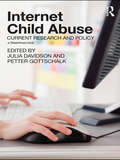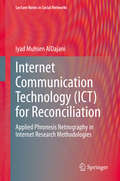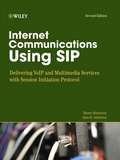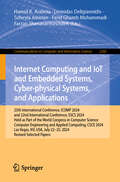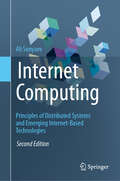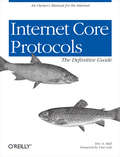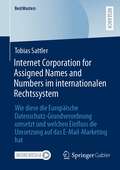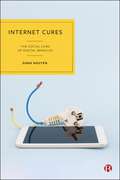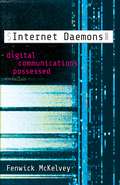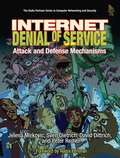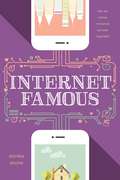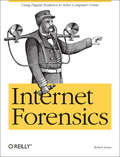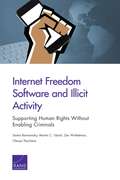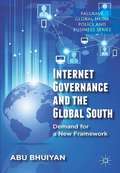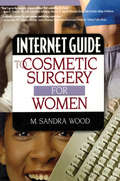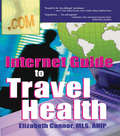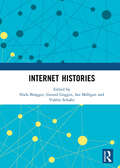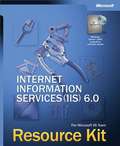- Table View
- List View
Internet Child Abuse: Current Research and Policy
by Julia DavidsonInternet Child Abuse: Current Research and Policy provides a timely overview of international policy, legislation and offender management and treatment practice in the area of Internet child abuse. Internet use has grown considerably over the last five years, and information technology now forms a core part of the formal education system in many countries. There is however, increasing evidence that the Internet is used by some adults to access children and young people in order to ‘groom’ them for the purposes of sexual abuse; as well as to produce and distribute indecent illegal images of children. This book presents and assesses the most recent and current research on internet child abuse, addressing: its nature, the behaviour and treatment of its perpetrators, international policy, legislation and protection, and policing. It will be required reading for an international audience of academics, researchers, policy-makers and criminal justice practitioners with interests in this area.
Internet Communication Technology: Applied Phronesis Netnography in Internet Research Methodologies (Lecture Notes in Social Networks)
by Iyad Muhsen AlDajaniThe book explores Applied Phronesis in internet communication technology and Netnography application, introducing it on Facebook and YouTube usages. It defines two pillars for the research dynamics, “Episteme” and “Techne.” – the know-how, how-to, and the power dynamics. The “Episteme” explores the dynamics of reconciliation in the middle of conflict, Internet communication technologies for transformation, Moderation in Islam, online Deliberative Democracy.The second pillar, “Techne,” is explored through Internet communication technology for the advancement of reconciliation in the middle of a conflict.The book describes the Phronetic Approach in internet research in academic discourse adopting Phronesis “an Aristotelian concept and method defined by Bent Flyvbjerg,” and exploring Netnography for Kozinets, in Mixed-Method research design and applying methodological triangulation in research and testing the hypothesis using qualitative content analysis for Krippendorff, developing a methodological discourse for interdisciplinary research using internet communication technologies as part of understanding big-date, introducing Applied Digital Humanities.
Internet Communications Using SIP
by Henry Sinnreich Alan B. Johnston"This book is like a good tour guide.It doesn't just describe the major attractions; you share in the history, spirit, language, and culture of the place."--Henning Schulzrinne, Professor, Columbia UniversitySince its birth in 1996, Session Initiation Protocol (SIP) has grown up. As a richer, much more robust technology, SIP today is fully capable of supporting the communication systems that power our twenty-first century work and life.This second edition handbook has been revamped to cover the newest standards, services, and products. You'll find the latest on SIP usage beyond VoIP, including Presence, instant messaging (IM), mobility, and emergency services, as well as peer-to-peer SIP applications, quality-of-service, and security issues--everything you need to build and deploy today's SIP services.This book will help you* Work with SIP in Presence and event-based communications* Handle SIP-based application-level mobility issues* Develop applications to facilitate communications access for users with disabilities* Set up Internet-based emergency services* Explore how peer-to-peer SIP systems may change VoIP* Understand the critical importance of Internet transparency* Identify relevant standards and specifications* Handle potential quality-of-service and security problems
Internet Computing and IoT and Embedded Systems, Cyber-physical Systems, and Applications: 25th International Conference, ICOMP 2024, and 22nd International Conference, ESCS 2024, Held as Part of the World Congress in Computer Science, Computer Engineering and Applied Computing, CSCE 2024, Las Vegas, NV, USA, July 22–25, 2024, Revised Selected Papers (Communications in Computer and Information Science #2260)
by Hamid R. Arabnia Leonidas Deligiannidis Soheyla Amirian Farzan Shenavarmasouleh Farid Ghareh MohammadiThis book constitutes the proceedings of the 25th International Conference on Internet Computing and IoT, ICOMP 2024, and the 22nd International Conference on Embedded Systems, Cyber-physical Systems, and Applications, ESCS 2024, held as part of the 2024 World Congress in Computer Science, Computer Engineering and Applied Computing, in Las Vegas, USA, during July 22 to July 25, 2024. The 23 papers from IVOMP 2024 have been carefully reviewed and selected from 122 submissions. ESCS 2024 received 49 submissions and accepted 11 papers for inclusion in the proceedings. The papers have been organized in topical sections as follows: Internet computing and IoT - Cloud and Internet of Things; Internet computing and IoT - algorithms and applications; and embedded systems, cyber-physical systems and applications.
Internet Computing: Principles of Distributed Systems and Emerging Internet-Based Technologies
by Ali SunyaevThe 2nd edition of this well-established textbook introduces the reader to the fundamentals of contemporary and emerging technologies and services in Internet computing. It covers essential concepts such as distributed systems architecture and web technologies, contemporary paradigms such as cloud, fog, and edge computing, the Internet of things, and emerging technologies like distributed ledger technologies and the InterPlanetary File System. The book also highlights the interconnection and recombination of these Internet-based technologies, which together form a critical information infrastructure with major impacts on individuals, organizations, governments, economies, and society as a whole. Intended as a textbook for upper undergraduate and graduate classes, it features a wealth of examples, learning goals and summaries for every chapter, numerous recommendations for further reading, and questions for checking students’ comprehension. A dedicated author website offers additional teaching material and more elaborate examples. Accordingly, the book enables students and young professionals in IT-related fields to familiarize themselves with the Internet’s basic mechanisms, and with the most promising Internet-based technologies of our time.
Internet Core Protocols: Help for Network Administrators
by Eric HallIf you've ever been responsible for a network, you know that sinking feeling: your pager has gone off at 2 a.m., the network is broken, and you can't figure out why by using a dial-in connection from home. You drive into the office, dig out your protocol analyzer, and spend the next fourhours trying to put things back together before the staff shows up for work.When this happens, you often find yourself looking at the low-level guts of the Internet protocols: you're deciphering individual packets, trying to figure out what is (or isn't) happening. Until now, the only real guide to the protocols has been the Internet RFCs--and they're hardlywhat you want to be reading late at night when your network is down. There hasn't been a good book on the fundamentals of IP networking aimed at network administrators--until now.Internet Core Protocols: The Definitive Guide contains all the information you need for low-level network debugging. It provides thorough coverage of the fundamental protocols in the TCP/IP suite: IP, TCP, UDP, ICMP, ARP (in its many variations), and IGMP. (The companion volume, Internet Application Protocols: The Definitive Guide,provides detailed information about the commonly used application protocols, including HTTP, FTP, DNS, POP3, and many others). It includes many packet captures, showing you what to look for and how to interpret all the fields. It has been brought up to date with the latest developments in real-world IP networking. The CD-ROM included with the book contains Shomiti's "Surveyor Lite," a packet analyzer that runs on Win32 systems, plus the original RFCs, should you need them for reference. Together, this package includes everything you need to troubleshoot your network--except coffee.
Internet Corporation for Assigned Names and Numbers im internationalen Rechtssystem: Wie diese die Europäische Datenschutz-Grundverordnung umsetzt und welchen Einfluss die Umsetzung auf das E-Mail-Marketing hat (BestMasters)
by Tobias SattlerFür den stabilen und sicheren Betrieb des Internets ist die US-amerikanische gemeinnützige Organisation Internet Corporation for Assigned Names and Numbers (ICANN) verantwortlich, wozu die Koordination der Vergabe von Domain-Namen gehört. Die Europäische Datenschutz-Grundverordnung (EU-DSGVO) dient der Vereinheitlichung des Datenschutzrechts und schützt die Verarbeitung von personenbezogenen Daten. Dies hat einen Einfluss auf die öffentlich zugänglichen Informationen von registrierten Domain-Namen, deren Veröffentlichung die ICANN in ihren Richtlinien vorschreibt. Diese Informationen umfassen personenbezogene Daten wie den Namen, die Postanschrift und die E-Mail-Adresse der Domain-innehabenden Person. Die ICANN änderte ihre Richtlinien, jedoch ist weiterhin die Veröffentlichung dieser Angaben möglich. In dem vorliegenden Buch werden die Auswirkungen der EU-DSGVO auf das E-Mail-Marketing und die Verwendung von E-Mail-Adressen für E-Mail-Kampagnen untersucht, insbesondere in Bezug auf unerwünschte E-Mail-Werbung. Dazu wird die folgende Forschungsfrage gestellt: Welchen Effekt hat die Veröffentlichung der E-Mail-Adresse der Domain-innehabenden Person in den WHOIS-Datenbanken auf die Anzahl eingehender unerwünschter Marketing-E-Mails?
Internet Cures: The Social Lives of Digital Miracles
by Dang NguyenIn health care, we come across daily promises of miraculous cures for various ailments. However, in the digital era, the dynamics of experiencing and practicing these remedies have changed. This book explores the intersection of miracle cures and technology, showcasing their transformation into hybrid forms, such as handwritten recipes captured in photos or tutorials streamed through videos. Combining computational social media data with ethnographic insights from Vietnam and the US, the book captures the interconnected lives of these cures in the digital realm with a unique methodology. Unravelling the intricate connections between social, technological, biomedical and non-biomedical spheres, this is a significant contribution to how social scientists study online media.
Internet Daemons: Digital Communications Possessed (Electronic Mediations)
by Fenwick McKelveyA complete history and theory of internet daemons brings these little-known—but very consequential—programs into the spotlight We&’re used to talking about how tech giants like Google, Facebook, and Amazon rule the internet, but what about daemons? Ubiquitous programs that have colonized the Net&’s infrastructure—as well as the devices we use to access it—daemons are little known. Fenwick McKelvey weaves together history, theory, and policy to give a full account of where daemons come from and how they influence our lives—including their role in hot-button issues like network neutrality.Going back to Victorian times and the popular thought experiment Maxwell&’s Demon, McKelvey charts how daemons evolved from concept to reality, eventually blossoming into the pandaemonium of code-based creatures that today orchestrates our internet. Digging into real-life examples like sluggish connection speeds, Comcast&’s efforts to control peer-to-peer networking, and Pirate Bay&’s attempts to elude daemonic control (and skirt copyright), McKelvey shows how daemons have been central to the internet, greatly influencing everyday users.Internet Daemons asks important questions about how much control is being handed over to these automated, autonomous programs, and the consequences for transparency and oversight.
Internet Denial of Service: Attack and Defense Mechanisms
by Jelena Mirkovic Sven Dietrich David Dittrich Peter ReiherSuddenly your Web server becomes unavailable. When you investigate, you realize that a flood of packets is surging into your network. You have just become one of the hundreds of thousands of victims of a denial-of-service attack, a pervasive and growing threat to the Internet. What do you do? <p><p> Internet Denial of Service sheds light on a complex and fascinating form of computer attack that impacts the confidentiality, integrity, and availability of millions of computers worldwide. It tells the network administrator, corporate CTO, incident responder, and student how DDoS attacks are prepared and executed, how to think about DDoS, and how to arrange computer and network defenses. It also provides a suite of actions that can be taken before, during, and after an attack.
Internet Dos and Don'ts: Keep Your Passwords Secret
by Shannon MillerPasswords are important personal information that should not be shared--not even with a best friend. Readers will learn why password privacy is key to their safety and the potential consequences of telling others confidential information.
Internet Econometrics
by Serge Allegrezza Anne DubrocardThe proliferation of the internet has often been referred to as the fourth technological revolution. This book explores the diffusion of radical new communication technologies, and the subsequent transformation not only of products, but also of the organisation of production and business methods.
Internet Economics
by Lee W. Mcknight Joseph P. BaileyThe Internet has rapidly become an important element of the economic system. The lack of accepted metrics for economic analysis of Internet transactions is therefore increasingly problematic. This book, one of the first to bring together research on Internet engineering and economics, attempts to establish such metrics. The chapters, which developed out of a 1995 workshop held at MIT, include architectural models and analyses of Internet usage, as well as alternative pricing policies. The book is organized into six sections: 1) Introduction to Internet Economics, 2) The Economics of the Internet, 3) Interconnection and Multicast Economics, 4) Usage Sensitive Pricing, 5) Internet Commerce, and 6) Internet Economics and Policy. Contributors: Loretta Anania, Joseph P. Bailey, Nevil Brownlee, David Carver, David Clark, David W. Crawford, Ketil Danielsen, Deborah Estrin, Branko Gerovac, David Gingold, Jiong Gong, Alok Gupta, Shai Herzog, Clark Johnson, Martyne M. Hallgren, Frank P. Kelly, Charlie Lai, Alan K. McAdams, Jeffrey K. MacKie-Mason, Lee W. McKnight, Gennady Medvinsky, Liam Murphy, John Murphy, B. Clifford Neuman, Jon M. Peha, Joseph Reagle, Mitrabarun Sarkar, Scott Shenker, Marvin A. Sirbu, Richard Jay Solomon, Padmanabhan Srinagesh, Dale O. Stahl, Hal R. Varian, Qiong Wang, Martin Weiss, Andrew B. Whinston.
Internet Election Campaigns in the United States, Japan, South Korea, and Taiwan
by Diana Owen Shoko Kiyohara Kazuhiro MaeshimaThis book investigates how institutional differences, such as the roles of political parties and the regulation of electoral systems, affect the development of Internet election campaigns in the U. S. , Japan, Korea, and Taiwan. It examines whether or not the "Americanization of elections" is evident in East Asian democracies. While Japan is a parliamentary system, the U. S. and Korea are presidential systems and Taiwan is a semi-presidential system that has a president along with a parliamentary system. Furthermore, the role of the presidency in the U. S. , Korea, and Taiwan is quite different. Taking these variations in political systems into consideration, the authors discuss how the electoral systems are regulated in relation to issues such as paid advertisements and campaign periods. They argue that stronger regulation of election systems and shorter election periods in Japan characterize Japanese uniqueness compared with the U. S. , Korea, and Taiwan in terms of Internet election campaigns.
Internet Environments for Science Education
by Marcia C. LinnInternet Environments for Science Education synthesizes 25 years of research to identify effective, technology-enhanced ways to convert students into lifelong science learners--one inquiry project at a time. It offers design principles for development of innovations; features tested, customizable inquiry projects that students, teachers, and professional developers can enact and refine; and introduces new methods and assessments to investigate the impact of technology on inquiry learning. The methodology--design-based research studies--enables investigators to capture the impact of innovations in the complex, inertia-laden educational enterprise and to use these findings to improve the innovation. The approach--technology-enhanced inquiry--takes advantage of global, networked information resources, sociocognitive research, and advances in technology combined in responsive learning environments. Internet Environments for Science Education advocates leveraging inquiry and technology to reform the full spectrum of science education activities--including instruction, curriculum, policy, professional development, and assessment. The book offers: *the knowledge integration perspective on learning, featuring the interpretive, cultural, and deliberate natures of the learner; *the scaffolded knowledge integration framework on instruction summarized in meta-principles and pragmatic principles for design of inquiry instruction; *a series of learning environments, including the Computer as Learning Partner (CLP), the Knowledge Integration Environment (KIE), and the Web-based Inquiry Science Environment (WISE) that designers can use to create new inquiry projects, customize existing projects, or inspire thinking about other learning environments; *curriculum design patterns for inquiry projects describing activity sequences to promote critique, debate, design, and investigation in science; *a partnership model establishing activity structures for teachers, pedagogical researchers, discipline experts, and technologists to jointly design and refine inquiry instruction; *a professional development model involving mentoring by an expert teacher; *projects about contemporary controversy enabling students to explore the nature of science; *a customization process guiding teachers to adapt inquiry projects to their own students, geographical characteristics, curriculum framework, and personal goals; and *a Web site providing additional links, resources, and community tools at www.InternetScienceEducation.org
Internet Famous
by Danika Stone<P>An engaging and relatable novel for the digital age that perfectly captures the complicated interaction between what goes on in our real lives and what we say online. <P>Internet sensation Madison Nakama has it all! Her pop-culture rewatch site has a massive following, and fans across the world wait on her every post and tweet. And now Laurent, a fellow geek (and unfairly HOT French exchange student!), has started flirting with her in the comments section of her blog. But Laurent’s not the only one watching for Madi’s replies… Internet fame has a price, and their online romance sparks the unwanted attention of a troll. <P>When Madi’s “real life” hits a rough patch, she feels her whole world crumbling. With Laurent’s support, can Madi rally her friends across the globe to beat the troll, or will he succeed in driving her away from everything—and everyone—she loves? <P>Internet Famous is a fresh, contemporary young adult romance for the iGeneration from Danika Stone, author of All the Feels.
Internet Forensics: Using Digital Evidence to Solve Computer Crime
by Robert JonesBecause it's so large and unregulated, the Internet is a fertile breeding ground for all kinds of scams and schemes. Usually it's your credit card number they're after, and they won't stop there. Not just mere annoyances, these scams are real crimes, with real victims. Now, thanks to Internet Forensics from O'Reilly, there's something you can do about it.This practical guide to defending against Internet fraud gives you the skills you need to uncover the origins of the spammers, con artists, and identity thieves that plague the Internet. Targeted primarily at the developer community, Internet Forensics shows you how to extract the information that lies hidden in every email message, web page, and web server on the Internet. It describes the lengths the bad guys will go to cover their tracks, and offers tricks that you can use to see through their disguises. You'll also gain an understanding for how the Internet functions, and how spammers use these protocols to their devious advantage.The book is organized around the core technologies of the Internet-email, web sites, servers, and browsers. Chapters describe how these are used and abused and show you how information hidden in each of them can be revealed. Short examples illustrate all the major techniques that are discussed. The ethical and legal issues that arise in the uncovering of Internet abuse are also addressed.Not surprisingly, the audience for Internet Forensics is boundless. For developers, it's a serious foray into the world of Internet security; for weekend surfers fed up with spam, it's an entertaining and fun guide that lets them play amateur detective from the safe confines of their home or office.
Internet Freedom Software and Illicit Activity: Supporting Human Rights Without Enabling Criminals
by Martin C. Libicki Olesya Tkacheva Sasha Romanosky Zev WinkelmanThis report examines the portfolio of tools funded by the State Department s Bureau of Democracy, Human Rights, and Labor that help support Internet freedom and assesses the impact of these tools in promoting U. S. interests (such as freedom of expression, freedom of the press, and the free flow of information) without enabling criminal activity. "
Internet Governance and the Global South
by Abu BhuiyanA welcome addition to Palgrave's Global Media Policy and Business series, Internet Governance and the Global South documents the role of the global south in Internet policymaking and challenges the globalization theories that declared the death of the state in global decision-making. Abu Bhuiyan argues that the global Internet politics is primarily a conflict between the states - the United States of America and the states of the global south - because the former controls Internet policymaking. The states of the global south have been both oppositional and acquiescing to the sponsored policies of the United States on Internet issues such as digital divide, multilingualism, intellectual property rights and cyber security. They do not oppose the neoliberal underpinnings of the policies promoted by the United States, but ask for an international framework to govern the Internet so that they can work as equal partners in setting norms for the global Internet.
Internet Governance: The NETmundial Roadmap
by Monroe E. Price Patrick Ryan Larry Gross Arlene Luck Joana Varon Ferraz Matthew Shears Ronaldo Lemos Vint Cerf Emma Llansó William J. Drake Max Senges Shawn Powers Jeremy Malcolm Lea Kaspar Nnenna Nwakanma Anriette Esterhuysen Avri Doria Samantha Dickinson Wolfgang Kleinwächter Richard Whitt Markus Kummer James Losey Marilia Maciel"Following up on the promise of the NETMundial meeting, this timely and useful book explores the challenges of implementing its roadmap for the future of Internet governance." -- Milton L. Mueller, Professor, Syracuse University School of Information Studies, USAInternet Governance: The NETmundial Roadmap explores key implications of the Global Meeting on the Future of Internet Governance held on April 23-24, 2014 in São Paulo, Brazil. At the meeting, government, business, civil society, Internet technical community and academic participants from around the world agreed to a "NETmundial Multistakeholder Statement" that included a "Roadmap for the Future Evolution of Internet Governance." This volume brings together leading practitioners and scholars to explore the challenges of implementing the Roadmap's section on institutional improvements, and was prepared for release and debate at September 2014 global Internet Governance Forum in Istanbul. The 16 chapters are grouped into six sections: Overviews; Strengthening the Internet Governance Forum; Filling the Gaps; Improving ICANN; Broader Analytical Perspectives; and Moving Forward. The book was produced as a part of the Internet Policy Observatory, a program at the Center for Global Communication Studies, the Annenberg School for Communication at the University of Pennsylvania. It is edited by William J. Drake of the University of Zurich and Monroe Price of the Annenberg School for Communication.
Internet Guide to Cosmetic Surgery for Women
by M Sandra WoodLearn to use the Internet to find important information on cosmetic surgery procedures-and the right surgeon to do it!Hundreds of thousands are considering cosmetic surgery of some sort. The question is where can you go to find out what is right for you? The Internet Guide to Cosmetic Surgery for Women gives you the advantage of finding out everything you want to know about cosmetic surgery-from the comfort and privacy of your own home. This comprehensive resource guides you through the mountains of information on the Internet, providing a thorough listing of Web sites detailing every aspect of plastic and cosmetic surgery for every body part, as well as presenting strategies for finding specific information you are looking for. The Internet Guide to Cosmetic Surgery for Women gives you the tools to find information about a specific procedure, learn the surgery&’s advantages as well as risks-even how to locate the best surgeons for the procedure. The book provides screen shots to illustrate Web sites, information on where to find the latest important statistics and data, and helpful definitions for cosmetic surgery terms.The Internet Guide to Cosmetic Surgery for Women not only lists Internet addresses and basic sites on cosmetic surgery, but also reveals where to find quality information on: the costs of surgery selecting a cosmetic surgeon liposuction calf implants tummy tucks thigh lifts buttock liposculpture buttock augmentation belt lipectomy breast surgeries, including enlargement, lifts, reconstruction, and reduction cheek implants facelifts jaw augmentation laser skin resurfacing lip augmentation nose surgery cellulite treatment Botox injections hair removal hair transplantation scar revision wrinkle treatment chemical peels cosmetic dentistry and much more!The Internet Guide to Cosmetic Surgery for Women is an essential guide for anyone interested in or considering plastic and cosmetic surgery procedures.
Internet Guide to Travel Health
by Elizabeth ConnorDiscover the best Web sites for you and your family&’s well-being while traveling! The Internet Guide to Travel Health is your one-stop resource for when you need authoritative, reliable, and up-to-date information for preventing or dealing with illness and injury while traveling in the United States and abroad. For persons traveling near or far, this useful, easy-to-consult guide identifies dependable Web sites with advice, tips, and accurate facts on health issues that can affect your travel plans. You&’ll save time and effort when researching the planning, preparation, and preventive measures necessary to stay healthy while traveling. In the Internet Guide to Travel Health, you will discover a wealth of information for maintaining your health and safety throughout your trip. This book offers you Web sites to keep you informed on the latest life-threatening situations occurring throughout the world, such as disease outbreaks, epidemics, and natural disasters. With Internet addresses for what health documents to keep with you at all times, how to find doctors and clinics at your destination, and even what to do in case of a death far from home, this informative guide helps you stay organized, even in an emergency. The Internet Guide to Travel Health provides you with reliable information on: elective and compulsory immunizations, vaccinations, and examinations safety concerns with specific modes of travel-automotive, railways, air travel, cruise ships travel recommendations and accommodations for people with disabilities, seniors, children, people with HIV, and pets specific diseases, conditions, and ailments that can affect travel or be encountered while traveling-from air rage and allergies to West Nile Virus and Yellow Fever interactive tools and real-time travel advice-driving distance calculators, air flight arrival/departure delays, and traffic reports In addition to the Web site listings, the Internet Guide to Travel Health provides numerous screen shots of key Internet resources and an understandable glossary of health- and Internet-related terms. With the myriad of health and safety risks associated with traveling both nationally and internationally, this book is essential for vacationers, business travelers, explorers, and health care professionals who want to stay informed and prepared.
Internet Histories
by Niels Brügger, Gerard Goggin, Ian Milligan and Valérie SchaferIn 2017, the new journal Internet Histories was founded. As part of the process of defining a new field, the journal editors approached leading scholars in this dynamic, interdisciplinary area. This book is thus a collection of eighteen short thought-provoking pieces, inviting discussion about Internet histories. They raise and suggest current and future issues in the scholarship, as well as exploring the challenges, opportunities, and tensions that underpin the research terrain. The book explores cultural, political, social, economic, and industrial dynamics, all part of a distinctive historiographical and theoretical approach which underpins this emerging field.The international specialists reflect upon the scholarly scene, laying out the field’s research successes to date, as well as suggest the future possibilities that lie ahead in the field of Internet histories. While the emphasis is on researcher perspectives, interviews with leading luminaries of the Internet’s development are also provided. As histories of the Internet become increasingly important, Internet Histories is a useful roadmap for those contemplating how we can write such works. One cannot write many histories of the 1990s or later without thinking of digital media – and we hope that Internet Histories will be an invaluable resource for such studies. This book was originally published as the first issue of the Internet Histories journal.
Internet Information Services (IIS) 6 Resource Kit
by Microsoft Iis TeamDeploy and support IIS 6.0, which is included with Microsoft Windows Server 2003, with expertise direct from the Microsoft IIS product team. This official RESOURCE KIT packs 1200+ pages of in-depth deployment, operations, and technical information, including step-by-step instructions for common administrative tasks. Get critical details and guidance on security enhancements, the new IIS 6.0 architecture, migration strategies, performance tuning, logging, and troubleshooting--along with timesaving tools, IIS 6.0 product documentation, and a searchable eBook on CD. You get all the resources you need to help maximize the security, reliability, manageability, and performance of your Web server--while reducing system administration costs. Get in-depth guidance--straight from the Microsoft IIS team on how to: Upgrade or migrate existing IIS solutions to IIS 6.0 Migrate Apache Web sites--migration tool included on CD Deploy Microsoft ASP.NET applications on IIS 6.0 Configure and manage IIS security services Manage the IIS 6.0 metabase using built-in GUI-based and command-line utilities Run IIS 6.0 as a platform for Web applications Streamline programmatic administration with the scripts and tools on CD Apply best practices for improving server availability and scalability, including managing large-scale deployments Optimize IIS performance with effective monitoring, tuning, and troubleshooting procedures Resource Kit tools plus Windows Server 2003 evaluation software inside Use IIS 6.0 Resource Kit tools to query log files, manage security features, run stress tests, migrate servers, troubleshoot problems, and more. The CD includes the following tools: Apache to IIS 6.0 Migration Tool CustomAuth IISCertDeploy.vbs IIS Host Helper Services IIS 6.0 Migration Tool IISState Log Parser Metabase Explorer Permissions Verifier RemapUrl SelfSSL TinyGet Web Capacity Analysis Tool WFetchCD also features: 180-day evaluation version of Windows Server 2003, Standard Edition IIS 6.0 Help system Windows Registry Reference Fully searchable eBook of this complete RESOURCE KIT A Note Regarding the CD or DVD The print version of this book ships with a CD or DVD. For those customers purchasing one of the digital formats in which this book is available, we are pleased to offer the CD/DVD content as a free download via O'Reilly Media's Digital Distribution services. To download this content, please visit O'Reilly's web site, search for the title of this book to find its catalog page, and click on the link below the cover image (Examples, Companion Content, or Practice Files). Note that while we provide as much of the media content as we are able via free download, we are sometimes limited by licensing restrictions. Please direct any questions or concerns to booktech@oreilly.com.
Internet Information Services (IIS) 6.0
by Microsoft CorporationDeploy and support Internet Information Services (IIS) 6.0 with tools and technical information straight from the Microsoft IIS product team.
